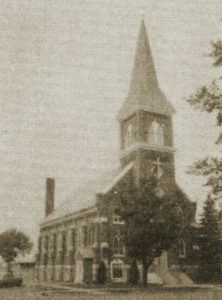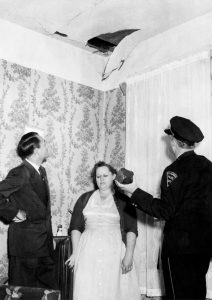meteorite

 It was in the middle of World War I, on the 4th of July, 1917. The citizens of Colby, Wisconsin were busy celebrating Independence Day. Colby was originally famous for the making of Colby cheese, but it was about to be famous for something else entirely. Around 6:30, the people were setting of fireworks and everyone was having a great time, when suddenly, there was a louder-than-it-should-have-been explosion. The people were startled and began to speculate as to the origin. Some thought it was dynamite set off by some over-zealous celebrators. Then, they dismissed that thought, and some of the townspeople were concerned that when the went outside, they might see a Zeppelin dropping German bombs on the little town. In the end it turned out to be something form much further away…outer space to be exact.
It was in the middle of World War I, on the 4th of July, 1917. The citizens of Colby, Wisconsin were busy celebrating Independence Day. Colby was originally famous for the making of Colby cheese, but it was about to be famous for something else entirely. Around 6:30, the people were setting of fireworks and everyone was having a great time, when suddenly, there was a louder-than-it-should-have-been explosion. The people were startled and began to speculate as to the origin. Some thought it was dynamite set off by some over-zealous celebrators. Then, they dismissed that thought, and some of the townspeople were concerned that when the went outside, they might see a Zeppelin dropping German bombs on the little town. In the end it turned out to be something form much further away…outer space to be exact.
The streak through the sky could have been missed because of the fireworks, but the explosion was another thing entirely. The meteorite hit just west of the Zion Lutheran Church, which is still there on the corner of West Jefferson Street and North 2nd Street in Colby, Wisconsin. When the townspeople located it easily, due to the smoke trail in the sky. They found that it had broken into two pieces, with the smaller piece landing just a short distance from the church, imbedded to a depth of one foot. It weighed about 75 pounds, and was said the be intensely cold, forming frost on it when it was uncovered. The larger piece landed in Joseph Jordan’s field, imbedding itself to a depth of five feet. The depth made it difficult to dig up, so it was not unearthed until the next morning when Professor Williams secured it for a school exhibit. That piece weighed about 300 pounds, and was apparently not as cold, probably due to the time spent in the ground.
It was said that another piece had landed in Cornell, Wisconsin, which is about 60 miles away from Colby. Amazingly, none of the other small towns in the area were hit. The principal of the Colby High School assumed,  correctly as it turns out that there were likely to be other fragments too. He did some digging in the area, and is said to have found a sizeable collection of fragments. Of course, that makes sense, because as a meteor streaks through our atmosphere, the intense heat, impacting the intense cold usually causes them to break up long before they impact the Earth’s surface. Still, every so often, a particularly sturdy meteor slips through without being totally obliterated, and then we have a strike, such as the one in Colby, Wisconsin in 1917.
correctly as it turns out that there were likely to be other fragments too. He did some digging in the area, and is said to have found a sizeable collection of fragments. Of course, that makes sense, because as a meteor streaks through our atmosphere, the intense heat, impacting the intense cold usually causes them to break up long before they impact the Earth’s surface. Still, every so often, a particularly sturdy meteor slips through without being totally obliterated, and then we have a strike, such as the one in Colby, Wisconsin in 1917.
According to the Wisconsin Geological and Natural History Survey, there have been 13 documented meteorite strikes in Wisconsin since 1860. The latest one was in April 2010. Often, the way that meteorites are discovered is that someone finds a rare mineral rock, and when checked, the chemical makeup of the stone indicates that it may have originated in outer space. Of course, that doesn’t document when it happened, or if it was actually part of a documented strike. We always have been and probably always will be fascinated by the extraterrestrial.
 When most people think of a meteor or meteorite hitting the earth, they think of the complete destruction of our planet, because that is the image portrayed by the movies, but the reality is that the earth gets hit quite a bit, and the effects are far from disastrous. What is far more unusual, and in reality, almost non existent, is the probability of a person getting hit by a meteorite, in fact, there may only be one known case of that at all.
When most people think of a meteor or meteorite hitting the earth, they think of the complete destruction of our planet, because that is the image portrayed by the movies, but the reality is that the earth gets hit quite a bit, and the effects are far from disastrous. What is far more unusual, and in reality, almost non existent, is the probability of a person getting hit by a meteorite, in fact, there may only be one known case of that at all.
The Sylacauga meteorite fell on November 30, 1954, at 12:46 local time in Oak Grove, Alabama, near Sylacauga. It is commonly called the Hodges meteorite because a fragment of it struck Ann Elizabeth Fowler Hodges (1920–1972). It is thought that Hodges is the only person ever hit by a meteorite, and the meteorite, while officially named the Sylacauga meteorite, was nicknamed the Hodges meteorite. As the meteorite made its way to Earth, the 8 1/2 pound grapefruit-sized chunk of space rock crashed through the roof of Hodges’ home, hit large wooden console radio, and ricocheted into her side and hand, while she napped on a couch. It left a nasty bruise, which looks eerily like a meteorite itself. It was the first documented extraterrestrial object to have injured a human being. The 34-year-old woman was badly bruised on one side of her body, but was able to walk. The event received worldwide publicity.
The meteor made a fireball visible from three states as it streaked through the atmosphere, even though it fell early in the afternoon. There were also indications of an air blast, as witnesses described hearing “explosions or loud booms”. The meteorite was confiscated by the Sylacauga police chief who then turned it over to the United States Air Force. Both Hodges and her landlord, Bertie Guy, claimed the rock, Guy’s claim being that it had fallen on her property. There were offers of up to $5,000 for the meteorite. Hodges and Bertie Guy settled, with Hodges paying $500 for the rock. However, by the time it was returned to Hodges, over a year later, public attention had diminished, and they were unable to then find a buyer. Ann Hodges was uncomfortable with the public attention and the stress of the dispute over ownership of the meteorite, so she donated it to the Alabama Museum of Natural History in 1956. The day after the fall, local farmer Julius McKinney came upon the second-largest fragment from the same meteorite. An Indianapolis-based lawyer purchased it for the Smithsonian Institution. The McKinney family was able to use the money to purchase a car and a house.

Upon the entry into the atmosphere, the Sylacauga meteorite fragmented into at least 3 pieces…the Hodges fragment 8.5 pounds that struck Ann Elizabeth Hodges. The McKinney fragment 3.7 pounds was found the next day December 1, 1954 by Julius Kempis McKinney, an African-American farmer who sold the meteorite fragment he found to purchase a car and a house. A third fragment is believed to have impacted somewhere near Childersburg northwest of Oak Grove. The meteoroid came in on the sunward side of the Earth, so when it hit, it had passed the perihelion and was traveling outward from the Sun. Considering the orbit estimations, the best candidate as parent body is 1685 Toro. The Sylacauga meteorite is classified as an ordinary chondrite of H4 group. I don’t suppose Ann Elizabeth Hodges cared what kind it was, just that it almost killed her.

